Maya Angelou
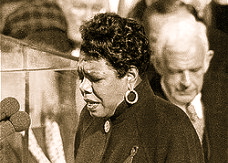
Maya Angelou: “I Know Why The Caged Bird Sings”
Written and released, 1969 — recorded 1996.
 Angelou reciting her poem, “On the Pulse of Morning”, at President Bill Clinton’s inauguration, January 1993
Angelou reciting her poem, “On the Pulse of Morning”, at President Bill Clinton’s inauguration, January 1993
Maya Angelou (/ˈmaɪ.ə ˈændʒəloʊ/; born Marguerite Ann Johnson; April 4, 1928 – May 28, 2014) was an American author and poet. She published seven autobiographies, three books of essays, and several books of poetry, and is credited with a list of plays, movies, and television shows spanning more than fifty years. She received dozens of awards and over thirty honorary doctoral degrees. Angelou is best known for her series of seven autobiographies, which focus on her childhood and early adult experiences. The first, I Know Why the Caged Bird Sings (1969), tells of her life up to the age of seventeen, and brought her international recognition and acclaim.
She became a poet and writer after a series of occupations as a young adult, including fry cook, prostitute, night-club dancer and performer, cast-member of the opera Porgy and Bess, coordinator for the Southern Christian Leadership Conference, and journalist in Egypt and Ghana during the days of decolonization. She was an actor, writer, director, and producer of plays, movies, and public television programs. Since 1982, she taught at Wake Forest University in Winston-Salem, North Carolina, where she held the first lifetime Reynolds Professorship of American Studies. She was active in the Civil Rights movement, and worked with Martin Luther King, Jr. and Malcolm X. Since the 1990’s she made around eighty appearances a year on the lecture circuit, something she continued into her eighties. In 1993, Angelou recited her poem “On the Pulse of Morning” at President Bill Clinton‘s inauguration, the first poet to make an inaugural recitation since Robert Frostat John F. Kennedy‘s inauguration in 1961.
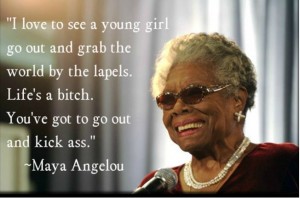 With the publication of I Know Why the Caged Bird Sings, Angelou publicly discussed aspects of her personal life. She was respected as a spokesperson of black people and women, and her works have been considered a defense of black culture. Attempts have been made to ban her books from some US libraries, but her works are widely used in schools and universities worldwide. Angelou’s major works have been labeled as autobiographical fiction, but many critics have characterized them as autobiographies. She made a deliberate attempt to challenge the common structure of the autobiography by critiquing, changing, and expanding the genre. Her books center on themes such as racism, identity, family, and travel. Angelou is best known for her autobiographies, but she was also an established poet.
With the publication of I Know Why the Caged Bird Sings, Angelou publicly discussed aspects of her personal life. She was respected as a spokesperson of black people and women, and her works have been considered a defense of black culture. Attempts have been made to ban her books from some US libraries, but her works are widely used in schools and universities worldwide. Angelou’s major works have been labeled as autobiographical fiction, but many critics have characterized them as autobiographies. She made a deliberate attempt to challenge the common structure of the autobiography by critiquing, changing, and expanding the genre. Her books center on themes such as racism, identity, family, and travel. Angelou is best known for her autobiographies, but she was also an established poet.
Life and career – Early Years
 Marguerite Johnson was born in St. Louis, Missouri, on April 4, 1928, the second child of Bailey Johnson, a doorman and a navy dietitian, and Vivian (Baxter) Johnson, a nurse and card dealer. Angelou’s older brother, Bailey Jr., nicknamed Marguerite “Maya,” derived from “My” or “Mya Sister.” When Angelou was three, and her brother four, their parents’ “calamitous marriage” ended, and their father sent them to Stamps, Arkansas, alone by train to live with their paternal grandmother, Annie Henderson. In “an astonishing exception” to the harsh economics of African-Americans of the time, Angelou’s grandmother prospered financially during the Great Depression and World War II because the general store she owned sold needed basic commodities and because “she made wise and honest investments.”
Marguerite Johnson was born in St. Louis, Missouri, on April 4, 1928, the second child of Bailey Johnson, a doorman and a navy dietitian, and Vivian (Baxter) Johnson, a nurse and card dealer. Angelou’s older brother, Bailey Jr., nicknamed Marguerite “Maya,” derived from “My” or “Mya Sister.” When Angelou was three, and her brother four, their parents’ “calamitous marriage” ended, and their father sent them to Stamps, Arkansas, alone by train to live with their paternal grandmother, Annie Henderson. In “an astonishing exception” to the harsh economics of African-Americans of the time, Angelou’s grandmother prospered financially during the Great Depression and World War II because the general store she owned sold needed basic commodities and because “she made wise and honest investments.”
And Angelou’s life has certainly been a full one: from the hardscrabble Depression era South to pimp, prostitute, supper-club chanteuse, performer in Porgy and Bess, coordinator for Martin Luther King Jr.’s Southern Christian Leadership Conference, journalist in Egypt and Ghana in the heady days of decolonization, comrade of Malcolm X, eyewitness to the Watts riots. She knew King and Malcolm, Billie Holiday and Abbey Lincoln.
Reviewer John McWhorter, The New Republic (McWhorter, p. 36)
To know her life story is to simultaneously wonder what on earth you have been doing with your own life and feel glad that you didn’t have to go through half the things she has.
The Guardian writer Gary Younge, 2009
Four years later, the children’s father “came to Stamps without warning” and returned them to their mother’s care in St. Louis. At the age of eight, while living with her mother, Angelou was sexually abused and raped by her mother’s boyfriend, a man named Freeman. She told her brother, who told the rest of their family. Freeman was found guilty but was jailed for only one day. Four days after his release, he was murdered, probably by Angelou’s uncles. Angelou became mute for almost five years, believing, as she stated, “I thought, my voice killed him; I killed that man, because I told his name. And then I thought I would never speak again, because my voice would kill anyone …” According to Marcia Ann Gillespie and her colleagues, who wrote a biography about Angelou, it was during this period of silence when Angelou developed her extraordinary memory, her love for books and literature, and her ability to listen and observe the world around her.
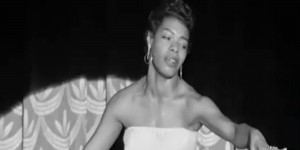 Shortly after Freeman’s murder, Angelou and her brother were sent back to their grandmother. Angelou credits a teacher and friend of her family, Mrs. Bertha Flowers, with helping her speak again. Flowers introduced her to authors such as Charles Dickens, William Shakespeare, Edgar Allan Poe, Douglas Johnson, and James Weldon Johnson, authors that would affect her life and career, as well as black female artists like Frances Harper, Anne Spencer, and Jessie Fauset. When Angelou was 14, she and her brother moved in with their mother once again; she had since moved to Oakland, California. During World War II, she attended George Washington High School while studying dance and drama on a scholarship at the California Labor School. Before graduating, she worked as the first black female streetcar conductor in San Francisco. Three weeks after completing school, at the age of 17, she gave birth to her son, Clyde (who later changed his name to Guy Johnson).
Shortly after Freeman’s murder, Angelou and her brother were sent back to their grandmother. Angelou credits a teacher and friend of her family, Mrs. Bertha Flowers, with helping her speak again. Flowers introduced her to authors such as Charles Dickens, William Shakespeare, Edgar Allan Poe, Douglas Johnson, and James Weldon Johnson, authors that would affect her life and career, as well as black female artists like Frances Harper, Anne Spencer, and Jessie Fauset. When Angelou was 14, she and her brother moved in with their mother once again; she had since moved to Oakland, California. During World War II, she attended George Washington High School while studying dance and drama on a scholarship at the California Labor School. Before graduating, she worked as the first black female streetcar conductor in San Francisco. Three weeks after completing school, at the age of 17, she gave birth to her son, Clyde (who later changed his name to Guy Johnson).
Angelou’s second autobiography, Gather Together in My Name, recounts her life from age 17 to 19 and “depicts a single mother’s slide down the social ladder into poverty and crime.” Angelou worked as “the front woman/business manager for prostitutes,” restaurant cook, and prostitute. She moved through a series of relationships, occupations, and cities as she attempted to raise her son without job training or advanced education.
Adulthood and Early Career: 1951–61
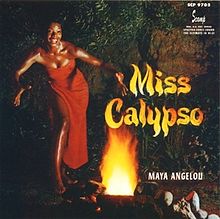 Angelou’s first album, Miss Calypso, produced in 1957, was made possible due to the popularity of her nightclub act.
Angelou’s first album, Miss Calypso, produced in 1957, was made possible due to the popularity of her nightclub act.
In 1951, Angelou married Greek electrician, former sailor, and aspiring musician, Tosh Angelos, despite the condemnation of interracial relationships at the time and the disapproval of her mother. She took modern dance classes during this time, and met dancers and choreographers Alvin Ailey and Ruth Beckford. Angelou and Ailey formed a dance team, calling themselves “Al and Rita,” and performed Modern Dance at fraternal black organizations throughout San Francisco, but never became successful. Angelou, her new husband, and her son moved to New York City so that she could study African dance with Trinidadian dancer Pearl Primus, but they returned to San Francisco a year later.
After Angelou’s marriage ended in 1954, she danced professionally in clubs around San Francisco, including the nightclub The Purple Onion, where she sang and danced calypso music. Up to that point she went by the name of “Marguerite Johnson”, or “Rita”, but at the strong suggestion of her managers and supporters at The Purple Onion she changed her professional name to “Maya Angelou,” a “distinctive name” that set her apart and captured the feel of her Calypso dance performances. During 1954 and 1955 Angelou toured Europe with a production of the opera Porgy and Bess. She began her practice of learning the language of every country she visited, and in a few years she gained proficiency in several languages. In 1957, riding on the popularity of calypso, Angelou recorded her first album, Miss Calypso, which was reissued as a CD in 1996. She appeared in an off-Broadway review that inspired the film Calypso Heat Wave, in which Angelou sang and performed her own compositions.
Angelou met novelist James O. Killens in 1959, and at his urging, moved to New York to concentrate on her writing career. She joined the Harlem Writers Guild, where she met several major African-American authors, including John Henrik Clarke, Rosa Guy, Paule Marshall, and Julian Mayfield, and was published for the first time. In 1960, after meeting civil rights leader Martin Luther King, Jr. and hearing him speak, she and Killens organized “the legendary” Cabaret for Freedomto benefit the Southern Christian Leadership Conference (SCLC), and she was named SCLC’s Northern Coordinator. According to scholar Lyman B. Hagen, her contributions to civil rights as a fundraiser and SCLC organizer were successful and “eminently effective.” Angelou also began her pro-Castro and anti-apartheid activism during this time.
Africa to Caged Bird: 1961–69
 Most of Angelou’s time in Africa was spent in Accra, Ghana, shown here in 2008.
Most of Angelou’s time in Africa was spent in Accra, Ghana, shown here in 2008.
In 1961, Angelou performed in Jean Genet‘s The Blacks, along with Abbey Lincoln, Roscoe Lee Brown, James Earl Jones, Louis Gossett, Godfrey Cambridge, and Cicely Tyson. That year she met South African freedom fighter Vusumzi Make; they never officially married.[40] She and her son Guy moved to Cairo with Make where Angelou worked as an associate editor at the weekly English-language newspaper The Arab Observer. In 1962 her relationship with Make ended, and she and Guy moved to Accra, Ghana, he to attend college, but he was seriously injured in an automobile accident. Angelou remained in Accra for his recovery and ended up staying there until 1965. She became an administrator at the University of Ghana, and was active in the African-American expatriate community. She was a feature editor for The African Review, a freelance writer for the Ghanaian Times, wrote and broadcast for Radio Ghana, and worked and performed for Ghana’s National Theatre. She performed in a revival of The Blacks in Geneva and Berlin.
In Accra, she became close friends with Malcolm X during his visit in the early 1960’s. Angelou returned to the U.S. in 1965 to help him build a new civil rights organization, the Organization of Afro-American Unity; he was assassinated shortly afterward. Devastated and adrift, she joined her brother in Hawaii, where she resumed her singing career, and then moved back to Los Angeles to focus on her writing career. She worked as a market researcher in Watts and witnessed the riots in the summer of 1965. She acted in and wrote plays, and returned to New York in 1967. She met her lifelong friend Rosa Guy and renewed her friendship with James Baldwin, whom she had met in Paris in the 1950’s and called “my brother”, during this time. Her friend Jerry Purcell provided Angelou with a stipend to support her writing.
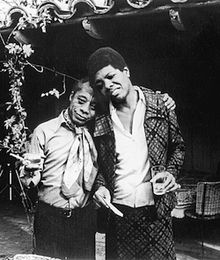 Angelou’s friend James Baldwinwas instrumental in the publication of her first autobiography.
Angelou’s friend James Baldwinwas instrumental in the publication of her first autobiography.
In 1968, Martin Luther King, Jr. asked Angelou to organize a march. She agreed, but “postpones again,” and in what Gillespie calls “a macabre twist of fate,” he was assassinated on her 40th birthday (April 4). Devastated again, she was encouraged out of her depression by her friend James Baldwin. As Gillespie states, “If 1968 was a year of great pain, loss, and sadness, it was also the year when America first witnessed the breadth and depth of Maya Angelou’s spirit and creative genius.” Despite almost no experience, she wrote, produced, and narrated “Blacks, Blues, Black!,”a ten-part series of documentaries about the connection between blues music and black Americans’ African heritage and what Angelou called the “Africanisms still current in the U.S.” for National Educational Television, the precursor of PBS. Also in 1968, inspired at a dinner party she attended with Baldwin, cartoonist Jules Feiffer, and his wife Judy, and challenged by Random House editor Robert Loomis, she wrote her first autobiography, I Know Why the Caged Bird Sings, published in 1969, which brought her international recognition and acclaim.
Later Career
Angelou’s Georgia, Georgia, produced by a Swedish film company and filmed in Sweden, the first screenplay written by a black woman, was released in 1972. She also wrote the film’s soundtrack, despite having very little additional input in the filming of the movie. Angelou married Welsh carpenter and ex-husband of Germaine Greer, Paul du Feu, in San Francisco in 1973. In the next ten years, as Gillespie has stated, “She had accomplished more than many artists hope to achieve in a lifetime.” She worked as a composer, writing for singer Roberta Flack and composing movie scores. She wrote articles, short stories, TV scripts and documentaries, autobiographies and poetry, produced plays, and was named visiting professors of several colleges and universities. She was “a reluctant actor,” and was nominated for a Tony Award in 1973 for her role in Look Away. In 1977 Angelou appeared in a supporting role in the television mini-series Roots. She was given a multitude of awards during this period, including over thirty honorary degrees from colleges and universities from all over the world.
In the late 1970s, Angelou met Oprah Winfrey when Winfrey was a TV anchor in Baltimore, Maryland; Angelou would later become Winfrey’s close friend and mentor. In 1981, Angelou and du Feu divorced. She returned to the southern United States in 1981, where she accepted the lifetime Reynolds Professorship of American Studies at Wake Forest University in Winston-Salem, North Carolina. From that point on, she considered herself “a teacher who writes.” Angelou taught a variety of subjects that reflected her interests, including philosophy, ethics, theology, science, theater, and writing.
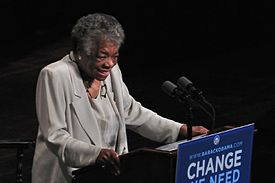 Maya Angelou speaking at a rally for Barack Obama, 2008
Maya Angelou speaking at a rally for Barack Obama, 2008
In 1993, Angelou recited her poem “On the Pulse of Morning” at the inauguration of President Bill Clinton, becoming the first poet to make an inaugural recitation since Robert Frost at John F. Kennedy’s inauguration in 1961. Her recitation resulted in more fame and recognition for her previous works, and broadened her appeal “across racial, economic, and educational boundaries.” The recording of the poem was awarded a Grammy Award. In June 1995, she delivered what Richard Long called her “second ‘public’ poem,” entitled “A Brave and Startling Truth,” which commemorated the 50th anniversary of the United Nations. Angelou achieved her goal of directing a feature film in 1996, Down in the Delta, which featured actors such as Alfre Woodard and Wesley Snipes. Since the 1990s, Angelou actively participated in the lecture circuit in a customized tour bus, something she continued into her eighties. In 2000, she created a successful collection of products for Hallmark, including greeting cards and decorative household items. Over thirty years after Angelou began writing her life story, she completed her sixth autobiography A Song Flung Up to Heaven, in 2002. In 2013, at the age of 85, she published the seventh autobiography in her series, Mom & Me & Mom, which focused on her relationship with her mother.
Angelou campaigned for Senator Hillary Clinton of the Democratic Party in the 2008 presidential primaries. When Clinton’s campaign ended, Angelou put her support behind Senator Barack Obama, who went on to win the election and become the first African American president of the United States. She stated, “We are growing up beyond the idiocies of racism and sexism.” In late 2010, Angelou donated her personal papers and career memorabilia to the Schomburg Center for Research in Black Culture in Harlem. They consisted of over 340 boxes of documents that featured her handwritten notes on yellow legal pads for I Know Why the Caged Bird Sings, a 1982 telegram from Coretta Scott King, fan mail, and personal and professional correspondence from colleagues such as her editor Robert Loomis.
Personal Life
I make writing as much a part of my life as I do eating or listening to music.
Maya Angelou, 1999
I also wear a hat or a very tightly pulled head tie when I write. I suppose I hope by doing that I will keep my brains from seeping out of my scalp and running in great gray blobs down my neck, into my ears, and over my face.
Maya Angelou, 1984
Nothing so frightens me as writing, but nothing so satisfies me. It’s like a swimmer in the [English] Channel: you face the stingrays and waves and cold and grease, and finally you reach the other shore, and you put your foot on the ground—Aaaahhhh!
Maya Angelou, 1989
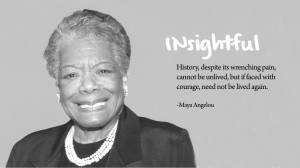 Evidence suggests that Angelou was partially descended from the Mende people of West Africa. A 2008 PBS documentary found that Angelou’s maternal great-grandmother Mary Lee, who had been emancipated after the Civil War, became pregnant by her former white owner, John Savin. Savin forced Lee to sign a false statement accusing another man of being the father of her child. After indicting Savin for forcing Lee to commit perjury, and despite discovering that Savin was the father, a jury found him not guilty. Lee was sent to the Clinton County poorhouse in Missouri with her daughter, Marguerite Baxter, who became Angelou’s grandmother. Angelou described Lee as “that poor little Black girl, physically and mentally bruised.”
Evidence suggests that Angelou was partially descended from the Mende people of West Africa. A 2008 PBS documentary found that Angelou’s maternal great-grandmother Mary Lee, who had been emancipated after the Civil War, became pregnant by her former white owner, John Savin. Savin forced Lee to sign a false statement accusing another man of being the father of her child. After indicting Savin for forcing Lee to commit perjury, and despite discovering that Savin was the father, a jury found him not guilty. Lee was sent to the Clinton County poorhouse in Missouri with her daughter, Marguerite Baxter, who became Angelou’s grandmother. Angelou described Lee as “that poor little Black girl, physically and mentally bruised.”
The details of Angelou’s life described in her seven autobiographies and in numerous interviews, speeches, and articles tended to be inconsistent. Critic Mary Jane Lupton has explained that when Angelou spoke about her life, she did so eloquently but informally and “with no time chart in front of her.” For example, she was married at least twice, but never clarified the number of times she has been married, “for fear of sounding frivolous”; according to her autobiographies and to Gillespie, she married Tosh Angelos in 1951 and Paul du Feu in 1973, and began her relationship with Vusumzi Make in 1961, but never formally married him. Angelou had one son Guy, whose birth was described in her first autobiography, one grandson, and two great-grandchildren, and according to Gillespie, a large group of friends and extended family. Angelou’s mother Vivian Baxter and brother Bailey Johnson, Jr., both of whom were important figures in her life and her books, have died; her mother in 1991 and her brother in 2000 after a series of strokes. In 1981, the mother of her son Guy’s child disappeared with Angelou’s grandson; it took eight years to find him. In 2009, the gossip website TMZ erroneously reported that Angelou had been hospitalized in Los Angeles when she was alive and well in St. Louis, which resulted in rumors of her death and according to Angelou, concern with her friends and family worldwide.
She did not earn a university degree, but according to Gillespie it was Angelou’s preference that she be called “Dr. Angelou” by people outside of her family and close friends. As of 2008, she owned two homes in Winston-Salem, North Carolina, and a “lordly brownstone” in Harlem, full of her “growing library” of books she collected throughout her life, artwork collected over the span of many decades, and well-stocked kitchens. Younge has reported that in her Harlem home resides several African wall hangings and Angelou’s collection of paintings, including ones of several jazz trumpeters, a watercolor of Rosa Parks, and a Faith Ringgold work entitled “Maya’s Quilt Of Life.” According to Gillespie, she hosted several celebrations per year at her main residence in Winston-Salem, including Thanksgiving; “her skill in the kitchen is the stuff of legend—from haute cuisine to down-home comfort food.” She combined her cooking and writing skills in her 2004 book Hallelujah! The Welcome Table, which featured 73 recipes, many of which she learned from her grandmother and mother, accompanied by 28 vignettes. She followed up with her second cookbook, Great Food, All Day Long: Cook Splendidly, Eat Smart in 2010, which focused on weight loss and portion control.Keep in mind that when taking dizziness is probable, especially in the first hours of the reception, so you need to be very careful when driving.
Beginning with I Know Why the Caged Bird Sings, Angelou used the same “writing ritual” for many years. She would wake early in the morning and check into a hotel room, where the staff was instructed to remove any pictures from the walls. She would write on legal pads while lying on the bed, with only a bottle of sherry, a deck of cards to play solitaire, Roget’s Thesaurus, and the Bible, and would leave by the early afternoon. She would average 10–12 pages of written material a day, which she edited down to three or four pages in the evening. Angelou went through this process to “enchant” herself, and as she said in a 1989 interview with the British Broadcasting Corporation, “relive the agony, the anguish, the Sturm und Drang.” She placed herself back in the time she wrote about, even traumatic experiences like her rape in Caged Bird, in order to “tell the human truth” about her life. Angelou stated that she played cards in order to get to that place of enchantment and in order to access her memories more effectively. She stated, “It may take an hour to get into it, but once I’m in it—ha! It’s so delicious!” She did not find the process cathartic; rather, she found relief in “telling the truth.”
Death
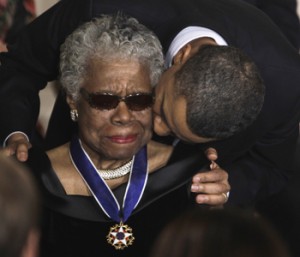 Angelou died on the morning of May 28, 2014, according to a family statement. She was found by her caregiver. She had reportedly been in poor health and had canceled recent scheduled appearances.
Angelou died on the morning of May 28, 2014, according to a family statement. She was found by her caregiver. She had reportedly been in poor health and had canceled recent scheduled appearances.
Tributes were paid by Barack Obama, who called her “one of the brightest lights of our time” and “a brilliant writer, a fierce friend and a truly phenomenal woman” and Bill Clinton, who described her works as “gifts of wisdom and wit, courage and grace.” Harold Augenbraum, from the National Book Foundation, said that Angelou’s “legacy is one that all writers and readers across the world can admire and aspire to.”
http://en.wikipedia.org/wiki/Maya_Angelou

